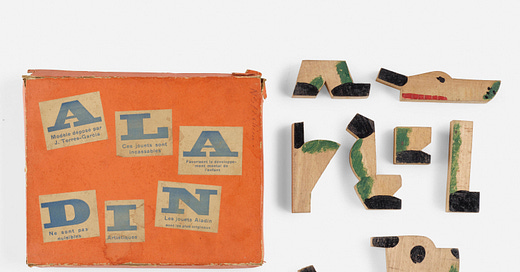Hello! This week’s Design Lobster is serving some frankly infantile design. We’re admiring some marvelous children’s toys that Uruguayan artist and designer Joaquín Torres-Garcia created in the early 20th century. I’m also sharing some thoughts on how designing for children might help us design better for everyone else too 👀

Before we get into it, I also want to shout out two incredible designers: Ranine Chav Khun and Mathieu Favreau of Faav Studio, Montreal who have been working with me on this spectacular hand-made stop-motion animation of the Design Lobster logo. I’m sure you’ll agree it perfectly captures personality of this newsletter! Watch a beautiful video of their (painstaking) linocut process here and don’t forget to reach out to them with your next motion design project 🪄
Right, on to this week’s issue 👇
Question: Should we always be designing for children?
The place I work—Monzo Bank—recently launched a children’s bank account in the UK, designed by a talented colleague of mine, Rob Corradi. This product required us to reimagine many parts of the core experience of a banking app from a child’s point of view: from logging in to seeing how much you’ve been spending. As a design team we were surprised to discover how this exercise changed how we felt about certain parts of the adult experience, opening our eyes to ways that it could be made simpler and friendlier.
These learnings reminded me of a 2013 IDEO project which had reimagined the experience of an MRI scan as a pirate-themed fairground ride. A disturbing 80% of children require sedation because of how frightening they find MRI machines and the new experience succeeded in significantly reducing the need for sedation in the hospitals where it was introduced.
Adults are not children, and I don’t want us to get carried away here, but I am intrigued by the idea that designing the ‘kids version’ helps us create something that works better for everyone else too. After all, why should adults have to put up with the scary or difficult version? What I am talking about really is inclusive design, but while this normally refers to adults of different backgrounds and abilities, I’m wondering if we should be including children too.
Just as the real challenge of knowing a topic is being able to successfully explain it to a six-year old (see today’s quote) so maybe the real test of a design is seeing how a six-reacts to it! If nothing else, I think this is a powerful thought experiment for us to have in our back pocket for the next design project.
Design takeaway: How well would your design work for a six year-old?
🏴☠️ Read the full story of the reimagined MRI machines
Object: Transformable toy
Joaquín Torres-García was born in Montevideo Uruguay in 1874 and went on to lead a rather remarkable polymath existence between Spain, New York and South America making painting, murals, sculpture and poetry. Inspired by his utopian ideas to bridge high and low art forms in 1917 he began a project to reimagine toys as modular works of art. These toys—like the dogs shown above that were manufactured by his company Aladin Toys in 1927—were open-ended puzzles designed were designed to be taken apart and rebuilt. Rather than constraining a child with a predetermined set of actions, the toys were transformable, meant to trigger their creativity and imagination.
Visually, their unpainted wood and minimalist shapes stood in stark contrast to intricately detailed tin toys that were common in the early 20th century. Torres-García’s artistic philosophy of Constructive Universalism was built on a universal visual language of abstract symbols, of which these toys were just one expression.
Design takeaway: How could you inspire more creative use of an everyday object?
In Design Lobster #46 we admired a beautiful jigsaw puzzle toy by Enzo Mari
Enjoying Design Lobster? Share it with a friend, colleague or fellow designer 🤲🦞
Quote: “If you can't explain it to a six year old, you don't understand it yourself.”
– Albert Einstein
We’ve all probably seen this quote before multiple times, but it felt perfect for this week’s theme. Whether we’re crafting a product, telling a story, or solving the mysteries of quantum mechanics, the challenge is always to distill complexity into clarity—without losing the essence of what really matters.
What better litmus test than a six-year-old then for your next design project—if they can understand and get excited, chances are everyone else will too!
May you have a wonderfully childish week,
Ben 🦞
Elsewhere…
👉 The future of product design is how it feels - Touch is our most complex sensory system by far. It is an essential part of processing our surroundings—but an overemphasis on digital experiences has led to a homogenized design language that flattens our ways of interacting with the world around us.
👎 Jaguar re-brand - the knives have been out in the last week for Jaguar’s baffling car-free rebrand this week. Maybe it would have worked in 2019 but the vibe has shifted.
🎨 Having taste - Whenever I am struck by someone’s taste, I love seeing how little influence our current moment has on them. As though this person’s world lives in a vacuum that without them couldn’t exist and it was never done for anyone but themselves.
❤️ How to do what you love - I recently rediscovered this brilliant 2006 Paul Graham essay on careers.
Enjoyed this week’s Design Lobster? Let me know by clicking the heart button ❤️
👇






Great insights! I think there’s a Venn diagram that overlaps universal design and design for kids - that’s the sweet spot we need to be designing for.
I DO in fact LOVE that lobster logo! And I sure do appreciate your awareness of kids as a central force to be considered.